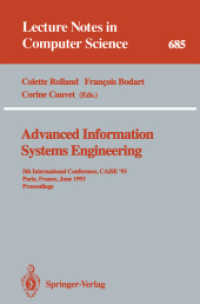- ホーム
- > 洋書
- > 英文書
- > Science / Mathematics
Full Description
Publisher's Note: Products purchased from Third Party sellers are not guaranteed by the publisher for quality, authenticity, or access to any online entitlements included with the product.Complete coverage of design and life assessment methods for high-temperature componentsApplied Creep Mechanics fully discusses the time-dependent deformation which occurs in a metal when subjected to stress at an elevated temperature. This book explains how to perform detailed analyses of welded components; assess the conditions under which cracks may initiate and grow; and extract valuable information about the current state of the material, which may have been in service for many years.
This practical guide provides tested techniques for improving the design and life assessment methods for high-temperature components in power plants, chemical plants, and aero engines. The information presented in this book will help you optimize maintenance and repair, save time, reduce costs, and improve operational efficiency.
Provides real-world industrial perspective on how to apply techniques to practical problems
Case studies with linear and non-linear material behavior models
Solution methods based on equilibrium compatibility and stress-strain and energy concepts
Discusses high-temperature creep of engineering components; high-temperature structural analysis; high-temperature fracture mechanics; and damage mechanics
Covers welded, notched, and cracked components
State-of-the-art coverage of thermo-mechanical fatigue (TMF)
Contents
Ch 1. Introduction
Ch 2. Relevant Material Behavior & Solid Mechanics Background
Ch 3. Material Behavior Models for Creep Analysis
Ch 4. Stationary-state Creep of Single Material, Uncracked Components
Ch 5. Inferences from Stationary-State Analyses of Single Material, Uncracked Components
Ch 6. Stationary-State Creep of Multi-Material, Uncracked Components
Ch 7. Application of the Finite Method to the Creep of Single Material Components
Ch 8. Creep of Welded Components
Ch 9. Creep of Notched Components
Ch 10. Creep of Cracked Components
Ch 11. Small Specimen Creep Testing
A1: Basis of the Finite Element Method
A2: Derivation of Lamés Equations
A3: The Complimentary Energy Method
A4: Indicial Notation
A5: Determination of the Reference Parameters, η and β, using the Finite Element Method







